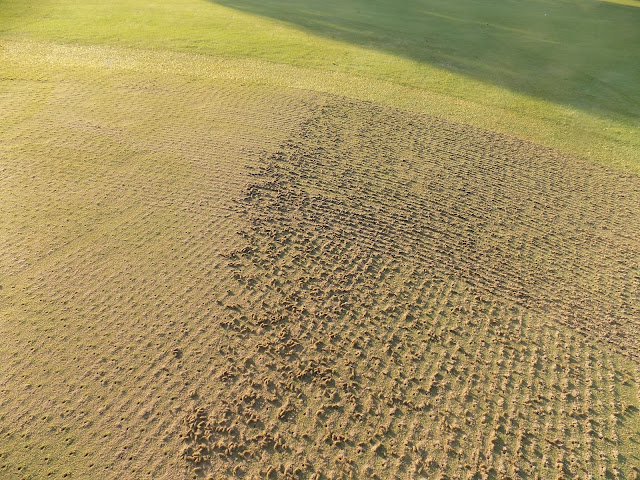Below are the pictures of the steps we took for spiking / aeration of the new putting greens this past Monday 7/25/22. We were watching the weather forecast and decided a 98 degree high for the forecast was about as good as we were going to get in July having postponed the Monday prior. Turned out to be quite pleasant and we experienced no weather related issues. For those that are interested, enjoy the pictorial of the process all the way through Tuesday AM.
 |
Step 2 Aerify Perimeter - To minimize any injury to the putting surface when operating the larger aerifyer we opted to use our smaller aerifyer in the perimeters of the putting surface. |
 |
Step 3 Cleanup - We use an assortment of blowers & shovels to remove all of the little cores. This is the labor intensive, time consuming step. |
 |
Little cores piling up during the clean-up process |
 |
Little cores appear larger then they are in this close-up picture. |
 |
Step 4 - Rolling the green. Little tufts around the small holes need to get rolled out. |
 |
Step 7 Irrigation - We would not irrigate the putting surface prior to a cultivation event like core aeration but definitely want to immediately afterwards for multiple reasons. First the process of opening the greens up exposes them to the elements and potential desiccation, so we want to re-hydrate. Secondly having all of these open holes allows us to easily irrigate the entire putting surface profile to complete saturation subsequently resulting in irrigation field capacity where there is a perfect balance of air and usable water for the plant. Getting the entire putting surface to this balance is not always easy in the absence of the open passageways provided by aeration. This is one of the main reasons we greenskeepers are always trying to poke holes in the turf. |
 |
View of #1 green after initial irrigation following aeration. |
 |
Step 9 - After we roll the greens we blow off any imperfections and accumulation of sand. |
I wrote about our poa annua prevention strategy last week as it related to spiking and aeration. We need to have flexibility to do these cultural practices outside seasons of poa germination. This means we need to carry out these practices in the summer and need to be careful undertaking them in extreme temperature's. Therefore we need to be flexible and adjust to summer weather forecasts.
Neglecting these proactive cultural practices is easy and happens all the time, usually to the playing surface detriment. Golfing events and weather and "the greens are perfect, why are you poking holes in them?", all play a part in neglecting doing the right things for the short and long term health of the playing surfaces. It's a WIN, WIN if we can stick to doing a few timely micro tine aeration or spiking events per year that accomplish agronomic necessities, mitigate poa encroachment and at the same time maintain a very playable putting surface.





No comments:
Post a Comment